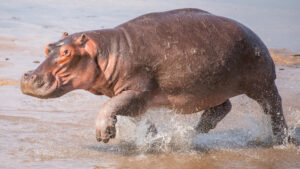The planet’s first Australians lived on a continent wholly different from what now exists.
To anyone familiar with the concepts of continental drift and climate change, that may not be a surprise. But a buried trove of cultural resources these Pleistocene people left behind could lead to new insights about Australia’s first inhabitants and the ancient art they created.
The Pleistocene supercontinent
Sahul is the Pleistocene supercontinent that comprised modern-day Australia, New Guinea, and Indonesia. Humans first found their way there somewhere around 50-65,000 years ago, by seafaring means that have stirred some debate.
The last ice age stranded them there about 10,000 years ago, and an archaeological mother lode confirmed their presence: Researchers unearthed thousands of stone tools and remnants of food scraps at the so-called Madjedbebe rock shelter in Australia’s Northern Territory.

Sunda and Sahul. Photo: Kanguole via Wiki Commons
But except for Madjedbebe, significant sites early Australians inhabited have proven scarce. To help, researchers and one group of Aboriginal rangers are engaged in an effort to reconstruct the ancient landscape they lived in, despite the fact it’s now buried below a floodplain.
The team and its lead researcher, Flinders University archeologist Jarrad Kowlessar, is collaborating with the Njanjma Rangers on the project. The Rangers are the “traditional owners” (or Aboriginal title holders) of the Greater Red Lily Lagoon Area in West Arnhem Land.
Not only can the project reveal what the ancient landscape used to look like, but it could also shed light on what influenced the era’s rock artists.
“We want people to see and know what’s been happening many thousand years ago in the past,” traditional owner and co-author Alfred Nayinggull said in a Flinders University press release.

As a traditional owner, Nayinggull has helped preserve rock art in the broader study area. Photo: Flinders University
Millennia of mangroves
Published in the journal PLOS ONE, the team’s paper demonstrates how environmental changes at the lagoon correlate to fish, crocodiles, and birds that appeared in artistic depictions.
“Based on the results of this study, all Pleistocene sites in western Arnhem Land were near the ocean and, subsequently, mangrove swamps at some point during the transformation of the landscape. This has important implications for the paleogeographic settings of these sites, which must be considered when interpreting changes in stone artifacts, food resources, and the isotope composition of materials from this period of the first Australians,” Kowlessar, the study’s lead author, explained.
The main problem with advancing the research was getting anywhere near the new site. While it was once a thriving valley and river system, it’s now locked under more than 15m of sediment deposited over the millennia by mangroves.

Samples from the team’s models of the now-buried ancient landscape. Photos: Flinders University
Don’t dig, electrocute
The technique they’re using to model the (potential) buried resources is called electrical resistivity tomography. In layman’s terms, it involves mildly electrocuting the ground, then measuring the waves as they pass through to find out what’s below.
The team combined those results with aerial mapping to produce a model of a forgotten site of ancient habitation.
One researcher not involved in the work told ABC News he’s skeptical that anything substantial remains there. Professor Paul Tacon, an archaeologist at Griffith University, told the outlet that any trace of a human touch could have degraded beyond recognition by now. Calling for further investigation, he still says it’s a promising use of the technology.
“Unfortunately if the rock art had been made at the habitation site there wouldn’t be much of it left because of the acidic soils and the amount of time it has been buried,” Tacon said. “There needs to be some sort of follow-up research to see if it is indeed evidence of Pleistocene habitation sites where they have suggested.”
Just keep digging — er, electrocuting?






